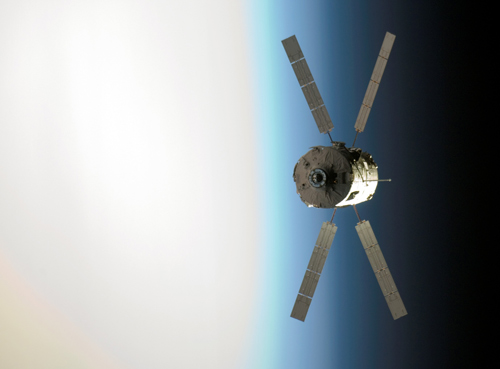Europe's First Space Station Cargo Ship to Dock Today

Europe?sfirst unmanned cargo ship is poised to make its inaugural docking at theInternational Space Station (ISS) Thursday after two successful dressrehearsals.
Following weeksof shakedown tests, the European Space Agency?s (ESA) automatedcargo ship Jules Verne is due to dock at the space station at about 10:40a.m. EDT (1440 GMT), with the outpost?s three-person crew keeping a watchfuleye on their incoming visitor.
?Weobviously want to keep close tabs on it as it approaches,? station commanderPeggy Whitson told reporters in a recent interview.
About thesize of a London double-decker bus, the 21-ton Jules Verne spacecraft is thefirst of ESA?s new fleet of AutomatedTransfer Vehicles (ATVs) to rendezvous with the ISS. Tucked aboard theorbital freighter are manuscripts written by its namesake, the 19th century sciencefiction writer Jules Verne, and a fresh load of supplies for the station?sExpedition 16 crew.
The JulesVerne ATV is about 32 feet (10 meters) long, 15 feet (4.5 meters) wide and cancarry about three times the 2.5-ton cargo shipments delivered to the ISS byunmanned Russian Progress vehicles. ESA officials have said it will be thelargest cargo carrier to the station once NASA?s space shuttle fleet retires in2010. If today?s docking is unsuccessful, a second attempt could be made onSaturday, they added.
NASA?sdeputy ISS program manager Kirk Shireman told reporters Wednesday that JulesVerne?s planned orbital arrival today has sparked excitement among flightcontrollers at the U.S. agency, as well as their counterparts in Europe andRussia.
?It?sreally been exciting?a great time to be part of the space station program,?Shireman said.
Get the Space.com Newsletter
Breaking space news, the latest updates on rocket launches, skywatching events and more!
JulesVerne launched into orbit on March 8 (ET) from Europe?s SouthAmerican-based spaceport in Kourou, French Guiana. The spacecraft spent severalweeks in orbit performing a series of intricate collision avoidance maneuversbefore catching up to the space station, where NASA?s shuttle Endeavour astronautswere hard at work adding a Japanese room and Canadian robot to the orbitinglab.
Afterwaiting patiently for Endeavour?s departure last week, Jules Verne?s flightcontrol team at the ESA?s dedicated ATV Control Center in Toulouse, France,ordered the autonomous spacecraft to make two approaches to the ISS that testedits video and laser-based rendezvous system.
Asuccessful March 29 rendezvous parked the spacecraft at a waypoint about 2miles (3.5 kilometers) from the station. That test was followed by a closerapproach on Monday, where Jules Verne hovered just 36 feet (11 meters) fromthe aft docking compartment of the station?s Russian-built Zvezda servicemodule. Malenchenko and Whitson successfully commanded Jules Verne to back awayfrom the station using their only means of control over the spacecraft, a redbutton reserved for emergencies if the vehicle strays off course, to end the Mondaydemonstration.
?Theysuccessfully passed the tests,? said Holly Ridings, NASA?s lead Expedition 16flight director, on Wednesday. ?It was very close to the space station,hovering right behind the service module aft of where it will dock.?
Russia?sspace station Mission Control Center in Korolev, outside Moscow, and its NASAcounterpart in at the Johnson Space Center in Houston will also be watchingover today?s docking attempt.
NASA will provide live coverage of the Jules Verne ATV?sspace station docking on NASA TV beginning at 8:00 a.m. EDT (1200 GMT). Click here for SPACE.com?s ISS missioncoverage and NASA TV feed.
- NEW VIDEO: Europe's Special Delivery to Space Station
- NEW VIDEO: Space Freighter ?Jules Verne? Launches into Orbit
- VIDEO: Part 1: Europe's First ISS Cargo Ship, Part 2
Join our Space Forums to keep talking space on the latest missions, night sky and more! And if you have a news tip, correction or comment, let us know at: community@space.com.

Tariq is the Editor-in-Chief of Space.com and joined the team in 2001, first as an intern and staff writer, and later as an editor. He covers human spaceflight, exploration and space science, as well as skywatching and entertainment. He became Space.com's Managing Editor in 2009 and Editor-in-Chief in 2019. Before joining Space.com, Tariq was a staff reporter for The Los Angeles Times covering education and city beats in La Habra, Fullerton and Huntington Beach. In October 2022, Tariq received the Harry Kolcum Award for excellence in space reporting from the National Space Club Florida Committee. He is also an Eagle Scout (yes, he has the Space Exploration merit badge) and went to Space Camp four times as a kid and a fifth time as an adult. He has journalism degrees from the University of Southern California and New York University. You can find Tariq at Space.com and as the co-host to the This Week In Space podcast with space historian Rod Pyle on the TWiT network. To see his latest project, you can follow Tariq on Twitter @tariqjmalik.









